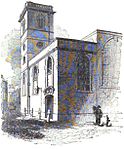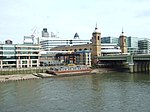Cannon Street train bombing
The Cannon Street train bombing was a bomb attack against commuter rail at Cannon Street station in the City of London, United Kingdom. A 10 lb (4.5 kg) bomb was detonated in an empty train at the terminus in the morning of Thursday 4 March 1976. The bomb wounded eight commuters in another passing train. The Provisional Irish Republican Army (IRA) was responsible for the blast.Minutes earlier, the train had been full of rush-hour commuters from Sevenoaks, and had the bomb exploded earlier it would have caused many more casualties and likely fatalities.At the time, the IRA was targeting trains in London. On 13 February 1976, a 20 lb (9.1 kg) bomb at Oxford Circus tube station was safely defused. Eleven days after Cannon Street, a 5 lb (2.3 kg) bomb prematurely detonated in a train at West Ham station. The next day, one man was injured in a tube train blast at Wood Green tube station.
Excerpt from the Wikipedia article Cannon Street train bombing (License: CC BY-SA 3.0, Authors).Cannon Street train bombing
Upper Thames Street, City of London
Geographical coordinates (GPS) Address Nearby Places Show on map
Geographical coordinates (GPS)
| Latitude | Longitude |
|---|---|
| N 51.5104 ° | E -0.0907 ° |
Address
Upper Thames Street
Upper Thames Street
EC4R 3UL City of London
England, United Kingdom
Open on Google Maps











